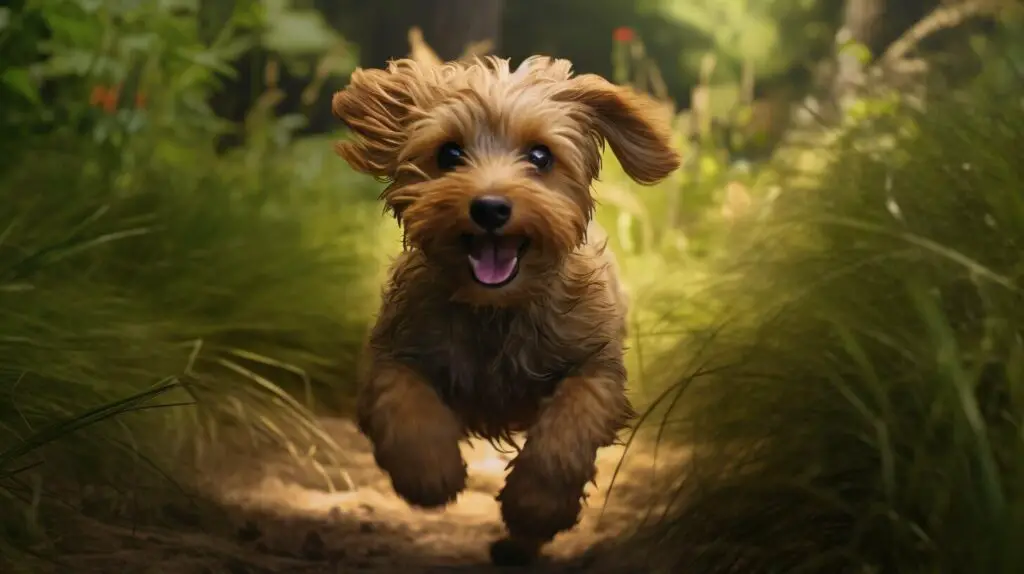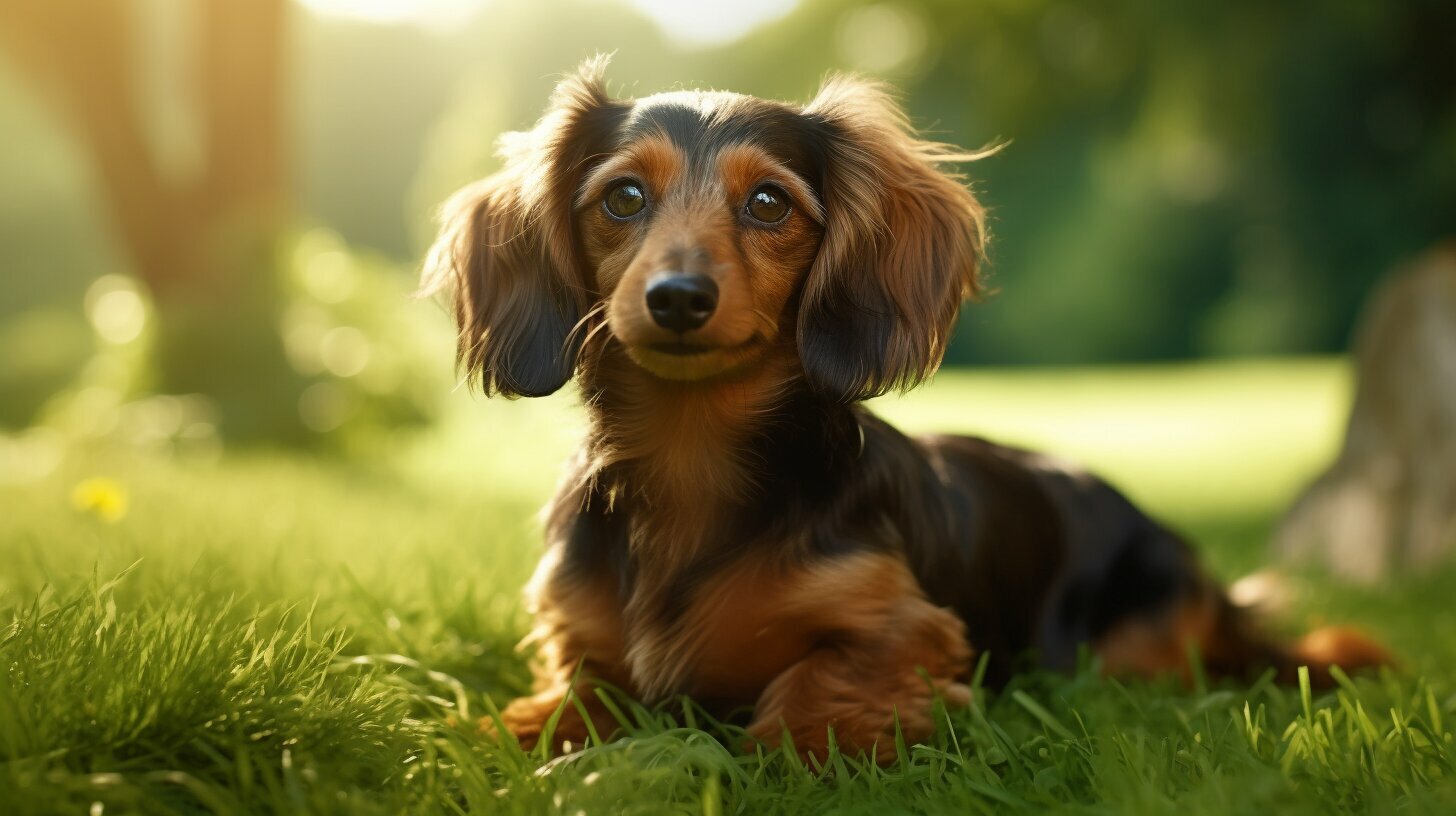What is a Doxiepoo? Discovering the Doxiepoo Breed
If you’re looking for a furry companion that’s equal parts Dachshund and Poodle, then you’ve come to the right place! The Doxiepoo is a hybrid dog breed that’s gaining popularity for its unique mix of qualities.
But what is a Doxiepoo exactly? A Doxiepoo is a mix of a Dachshund and a Poodle, resulting in a small to medium-sized dog that’s full of energy and affection. This friendly breed inherits the best traits from its parent breeds, combining the intelligence and hypoallergenic coats of Poodles with the spunk and loyalty of Dachshunds.
In this article, we’ll delve deeper into the characteristics, traits, and care of Doxiepoos. From their unique coat types to their exercise needs and family suitability, we’ll cover everything you need to know about this designer breed. So, let’s get started and discover the wonderful world of Doxiepoos!
- Understanding the Doxiepoo's Parent Breeds
- Coat Types and Colors
- Health Concerns in Doxiepoos
- Exercise and Activity Levels
- Training and Socialization
- Grooming and Care
- Doxiepoos as Family Pets
- Rescue and Adoption Options
- Living a Healthy Life with a Doxiepoo
- Frequently Asked Questions about Doxiepoos
- Final Thoughts on the Doxiepoo Breed
Understanding the Doxiepoo’s Parent Breeds
For anyone curious about the Doxiepoo breed, it’s essential to understand the two parent breeds that make up this unique hybrid dog. The Doxiepoo is a mix of a Dachshund and a Poodle, resulting in a dog that inherits traits from both breeds.
Dachshunds are known for their short legs, long bodies, and tenacious hunting skills. They are a popular breed that comes in a variety of sizes and coat types. On the other hand, Poodles are intelligent, active dogs that are often used as show dogs due to their elegant and curly coat. They also come in different sizes and are known for their hypoallergenic coat, making them a great choice for families with allergies.
When bred together, the resulting Doxiepoo can inherit any combination of traits from the parent breeds. This means that no two Doxiepoos are exactly the same and can vary in personality, coat type, and size.
Doxiepoos are considered part of the “designer dog” trend that has become increasingly popular in recent years. While some people still have reservations about hybrid breeds, Doxiepoos have gained a reputation as loving, loyal, and intelligent pets that make great family companions.
Coat Types and Colors
The Doxiepoo is a hybrid breed that can inherit coat types and colors from both of its parent breeds. The Dachshund is known for its short, smooth coat, while the Poodle has a curly, hypoallergenic coat. As a result, Doxiepoos can have a variety of coat types, including:
- Short and smooth
- Wavy or curly
- Wirehaired
The color of a Doxiepoo’s coat can also vary, with common colors including:
- Black
- Brown
- Red
- Cream
- Gray
Some Doxiepoos may also have markings such as white spots or patches on their coat.
It is important to note that Doxiepoos with curly coats will require more grooming than those with short, smooth coats. Regular brushing and grooming will help prevent matting and keep their coat healthy.
Health Concerns in Doxiepoos
Doxiepoos are generally healthy dogs, but like any other breed, they may be prone to certain health issues. It is important for owners to be aware of these potential health concerns and to work closely with their veterinarian to keep their Doxiepoo in good health.
Hip dysplasia is a common issue in Dachshunds and can also affect Doxiepoos. This is a hereditary condition in which the hip joint does not form properly, leading to arthritis and pain. Preventative measures include ensuring that Doxiepoos maintain a healthy weight and avoid excessive jumping or running.
Intervertebral disc disease (IVDD) is another condition that is common in Dachshunds and can also affect Doxiepoos. This occurs when the discs between the spinal vertebrae degenerate, leading to pain, paralysis, and even death in severe cases. Signs of IVDD include back pain, reluctance to move, and difficulty walking. Treatment options include medication, rest, and sometimes surgery.
Patellar luxation is a condition that affects the kneecap, causing it to dislocate from its normal position. This condition can lead to lameness and pain in affected dogs. Treatment options include medication and sometimes surgery.
Regular check-ups with a trusted veterinarian can help catch any potential health issues early on, allowing for more effective treatment options.
Exercise and Activity Levels
As a hybrid breed, Doxiepoos have energy levels that can vary depending on their individual traits and the characteristics they’ve inherited from their parent breeds. However, they generally require a moderate amount of daily exercise to keep them healthy and happy.
Daily exercise can include walks around the neighborhood, playing fetch, or running in the backyard. It’s important to ensure that they receive enough physical activity and mental stimulation to prevent boredom, as this can lead to destructive behavior.
How much exercise does a Doxiepoo need?
Most Doxiepoos require at least one 30-minute walk per day, but some may need more, especially if they have a lot of energy or if they don’t have access to a backyard. It’s important to remember that this is a hybrid breed and their energy levels may vary depending on their genetic makeup.
Younger Doxiepoos may require more activity to burn off excess energy, while older ones may have more relaxed exercise requirements. Nevertheless, all Doxiepoos require daily exercise to maintain their overall health and well-being.

Training and Socialization
Doxiepoos have a reputation for being stubborn, but with the right training techniques, they can be excellent learners. Positive reinforcement training is highly recommended for Doxiepoos, as punishment-based methods can lead to further stubbornness and even aggression.
Starting training and socialization early is crucial for Doxiepoos, as they can become wary of strangers and other animals if not properly socialized. Introducing them to a variety of people, animals, and environments at a young age can help prevent these issues.
Training Tips for Doxiepoos
1. Keep training sessions short and fun. Doxiepoos have a short attention span, so breaking up training into short sessions throughout the day can be more effective than longer sessions.
2. Use positive reinforcement, such as treats, praise, and play, to reward good behavior. Avoid punishing or scolding your Doxiepoo, as this can cause them to become defensive and less likely to obey in the future.
3. Be patient and consistent. Doxiepoos may take longer to learn certain commands, but with patience and consistency, they can become well-trained and obedient companions.
4. Attend obedience classes. Obedience classes can be a great way to socialize your Doxiepoo and work on training in a structured environment with professional guidance.
Overall, training and socialization are key to raising a well-behaved and happy Doxiepoo. With patience, consistency, and positive reinforcement, your Doxiepoo can become a delightful companion.
Grooming and Care
The Doxiepoo’s coat is one of its most distinguishing features. It can be curly, wavy, or straight, and it may take after either parent breed in terms of color. Regardless of the coat type, regular grooming is essential to keep your Doxiepoo looking and feeling its best.
If your Doxiepoo has curly hair, it will need to be brushed regularly to prevent matting and tangling. Use a wire pin brush, a slicker brush, or a comb to remove knots and tangles. You may also need to trim your Doxiepoo’s hair occasionally to keep it at a manageable length.
Like all dogs, Doxiepoos need good skin care. Keep your Doxiepoo’s skin healthy with a nutritious diet that includes plenty of vitamins and minerals. You can also use a gentle shampoo designed for dogs to keep your Doxiepoo’s coat and skin clean and moisturized.
Regular nail trimming is also important for Doxiepoos. Long nails can cause discomfort and pain when walking or running. Use a pet nail clipper or file to keep your Doxiepoo’s nails at a healthy length.
Finally, don’t forget about your Doxiepoo’s teeth! Regular tooth brushing and dental care can help prevent dental disease and keep your dog’s breath fresh. Offer dental chews and toys to help clean your Doxiepoo’s teeth and promote healthy chewing habits.
Regular grooming and care are essential for keeping your Doxiepoo healthy, happy, and looking great!
Doxiepoos as Family Pets
If you are considering getting a Doxiepoo as a family pet or companion, you will be pleased to know that they make great pets for many families. Doxiepoos are affectionate, loyal, and playful. They love spending time with their owners and are happy to curl up on the couch with you.
One of the advantages of owning a Doxiepoo is that they are highly adaptable to different living situations. Whether you live in an apartment or a house with a yard, they can thrive in many different environments. They are also well-suited for families with children, as they are gentle and patient with kids.
As with any dog, it is important to socialize your Doxiepoo from a young age to ensure they are comfortable around people and other dogs. This will help them develop into a well-behaved and confident adult dog. Positive reinforcement training techniques also work wonders with Doxiepoos, as they can have a stubborn streak like their Dachshund parent breed.
Overall, Doxiepoos can make wonderful family pets and lifelong companions for those who are willing to provide them with love, attention, and proper training.
Rescue and Adoption Options
Adopting a Doxiepoo can be a rewarding experience for both you and the dog. There are many rescue organizations across the country that specialize in finding homes for mixed breed dogs like the Doxiepoo. These organizations provide an opportunity for you to give a loving home to a dog that may have otherwise been abandoned or put down.
If you’re interested in adopting a Doxiepoo, start by contacting your local shelter or humane society. They may have Doxiepoos available for adoption or be able to point you in the right direction to find one. You can also search online for Doxiepoo rescue organizations in your area.
One benefit of adopting a mixed breed dog is that they often have fewer health issues than purebred dogs. This is because they have a wider gene pool, which can make them more resilient to certain diseases.
When adopting a Doxiepoo, it’s important to do your research and find a reputable rescue organization. You want to ensure that the dog has been well taken care of and that they are a good fit for your family and lifestyle.
“Adopting a Doxiepoo can be a rewarding experience for both you and the dog.”
Living a Healthy Life with a Doxiepoo
Maintaining a healthy lifestyle is essential to ensuring your Doxiepoo is happy and thriving. Here are some tips for keeping your furry friend healthy:
- Diet: Feed your Doxiepoo a well-balanced and nutritious diet. Consult with your veterinarian to determine the best food and portion sizes for your pet.
- Regular exercise: Daily walks and physical activity are crucial for your dog’s overall health and wellbeing. Make sure to provide enough exercise to meet their needs.
- Regular vet check-ups: Schedule regular visits with your veterinarian to monitor your dog’s health and address any issues early on. This can prevent more serious health problems from developing.
Remember, a healthy diet and exercise routine not only keep your Doxiepoo fit, but also help prevent health problems in the long run. A happy and healthy pet is a joy to have around!
Frequently Asked Questions about Doxiepoos
Here are some common questions and answers about the Doxiepoo breed:
What is a Doxiepoo?
A Doxiepoo is a hybrid breed created by crossing a Dachshund with a Poodle. They are also known as a Dachshund-Poodle mix.
Do Doxiepoos need a lot of exercise?
Doxiepoos are moderately active dogs and require regular exercise to keep them healthy and happy. They should have at least 30 minutes to an hour of exercise per day. This exercise can be in the form of walks, playtime, or other activities. Despite their small size, they are quite energetic and enjoy activities.
What are the common characteristics of a Doxiepoo?
Doxiepoos can inherit a variety of characteristics from their parent breeds, but they are generally friendly, affectionate, and intelligent dogs. They can be stubborn at times but respond well to positive reinforcement training methods.
What is the average size of a Doxiepoo?
As a hybrid breed, the size of a Doxiepoo can vary depending on the size of their parents. Generally, they range from small to medium-sized dogs, weighing between 10-30 pounds and standing 8-15 inches tall at the shoulder.
What is the typical lifespan of a Doxiepoo?
With proper care and regular vet check-ups, a Doxiepoo can live between 12 to 15 years.
What is the coat type and color of a Doxiepoo?
Doxiepoos can have a variety of coat types and colors depending on their parent breeds. They can have straight, wavy, or curly hair, and the colors can range from black, brown, cream, or a combination of these colors.
Are Doxiepoos good with children?
Yes, Doxiepoos can make great family pets and are usually good with children. As with any dog, it’s important to supervise interactions between children and dogs and teach children how to properly interact with dogs.
Doxiepoos have moderate exercise needs and typically require a daily walk and some playtime. They also benefit from mental stimulation activities to keep their minds engaged.
Can Doxiepoos live in apartments?
Yes, Doxiepoos can adapt well to apartment living as long as they receive enough exercise and mental stimulation. They are small to medium-sized dogs, making them a good choice for apartment dwellers.
Are there any health concerns for Doxiepoos?
Like all breeds, Doxiepoos may be prone to certain health issues. Some common health concerns include hip dysplasia, intervertebral disc disease, and patellar luxation. Regular vet check-ups and a healthy diet can help prevent these health issues.
Where can I adopt a Doxiepoo?
Adopting a Doxiepoo (a Dachshund and Poodle mix) can be done through various channels. Here are a few options:
Local Animal Shelters and Rescue Groups: Regularly check your local shelters or rescue groups. Some shelters will even let you leave your information and call you if a Doxiepoo comes in.
Online Adoption Networks: Websites such as Petfinder, Adopt-a-Pet, and Rescue Me allow you to search for specific breeds in your area.
Breed Specific Rescue Groups: Some rescue organizations focus on specific breeds. For Dachshunds, try Dachshund Rescue of North America. For Poodles, try Poodle Rescue of Houston. They might occasionally have Doxiepoos.
Doxiepoo Rescue Organizations: There might be organizations that specifically rescue Doxiepoos. A quick Google search will provide the closest one to your location.
Pet Adoption Events: Local pet stores and pet shows often have adoption events where you can meet many dogs at once.
Please remember that adoption requires commitment and every dog deserves a loving, permanent home. Also, consider adopting adult dogs as they are often harder to place than puppies.
Final Thoughts on the Doxiepoo Breed
The Doxiepoo breed is a unique and loveable designer breed that has gained popularity in recent years. These adorable dogs are a hybrid of the Dachshund and Poodle breeds and can inherit traits from both parent breeds. They have a friendly and affectionate personality and make great family pets and companions.
If you are considering bringing a Doxiepoo into your home, it is important to be prepared for the commitment and responsibilities that come with owning a dog. You will need to provide them with proper nutrition, regular exercise, and medical care to ensure they live a healthy and happy life.
When adopting a Doxiepoo, there are many rescue and adoption options available. Choosing to adopt not only saves a life, but it also allows you to give a loving home to a dog in need. Doxiepoos can make excellent apartment dogs, as they are adaptable to smaller living spaces.
The Unique Qualities of a Doxiepoo
One of the most unique qualities of a Doxiepoo is their curly hair, which can come in a variety of colors and patterns. Grooming is an important aspect of their care, as their curly hair can become easily tangled and matted if not regularly brushed. Additionally, they are prone to certain health issues such as hip dysplasia, intervertebral disc disease, and patellar luxation, so it is important to stay vigilant and take them to regular vet check-ups.
Training and socialization are also crucial for a Doxiepoo, as they can have a stubborn streak inherited from their Dachshund parent. Positive reinforcement methods are recommended to ensure a successful training experience.
Conclusion
If you are looking for a loving and adorable companion, a Doxiepoo may be the perfect fit for you. With proper care, training, and socialization, they can make great family pets and provide companionship for years to come. Remember to adopt a Doxiepoo from a shelter or rescue if possible and give them the loving home they deserve.


